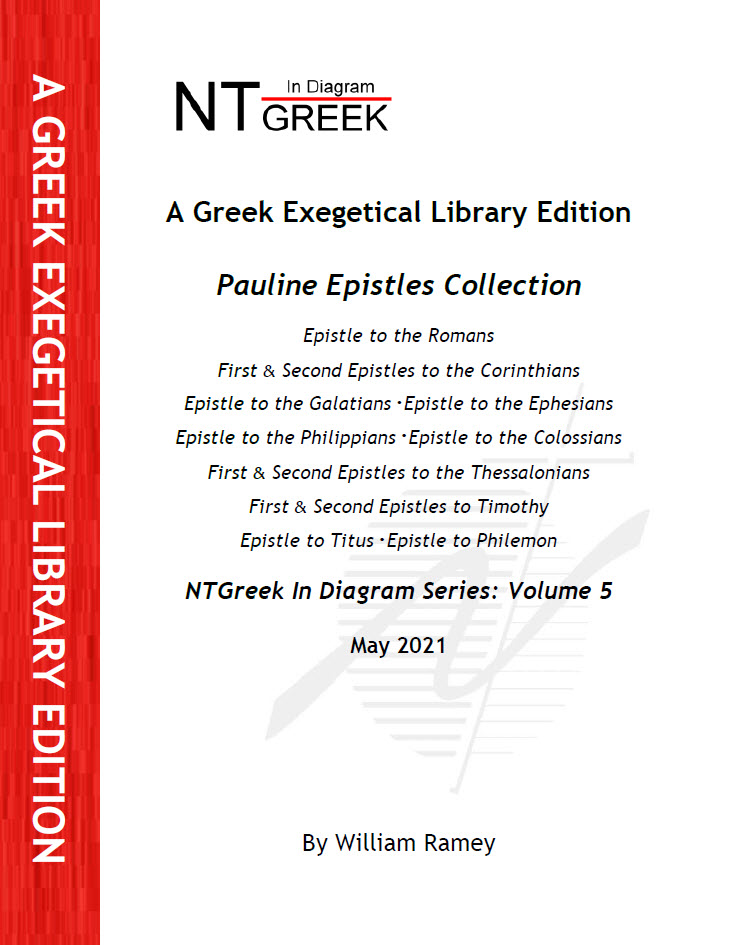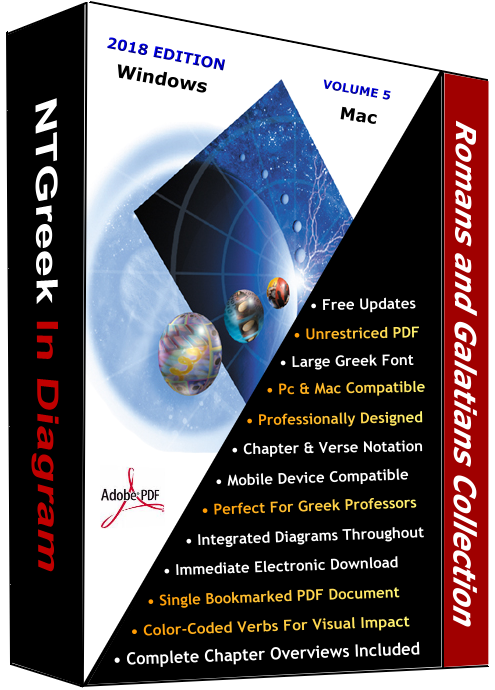

Title:
Pauline Epistles CollectionSeries:
NTGreek In Diagram: Volume 4Edition:
2021Last Update:
May 2021ISBN-10:
1939762154ISBN-13:
978-1-939762-15-3Language:
Greek diagrams with English commentsFormat:
Downloadable PDF bookmarked documentLength:
1,257 pages (including 87 oversized chapter diagram pages!)Price:
$39.95 USDThe apostle Paul authored most of the letters in the Greek New Testament, although Luke's two documents (Gospel of Luke Acts) account for nearly a third of the New Testament in volume. Of the twenty-seven documents, Paul authored thirteen. The Epistle to the Hebrews is correctly part of the General Epistles Collection. Internal evidence against Pauline authorship is too sold for dispute.
Paul's letters were written in accordance to formalized Hellenistic tradition. He wrote to particular assemblies and to individuals. Sometimes Paul's letters were divided into subgroups. For instance, the Prison Epistles are the ones written by him while he was in prison, while the Pastoral Epistles are the letters to Timothy and Titus, since they contain advice about providing pastoral care to their assemblies.
Structured diagrams for the Pauline literature are particularly helpful. Paul's syntax and sentence structure is involved and sometimes very complex. His arguments are tightly structured. Diagrams unravel an initial appearance of a maze of words. For example, Ephesians 1:3-14 is one sentence in Greek. If one cannot diagram this sentence, then Paul's syntax cannot be clearly grasped and appreciated.
Other examples may be found in the Epistle to the Philippians, which is a delightful letter and perfect to study Paul's logic and rhetorical style. His word order within sentences is remarkably flexible which goes beyond clause order. In some instances, he employs extraordinary syntax to express his inner heart-felt warmth toward those whom he cherished.
Because of the subject material, the Pastoral Epistles' syntax is generally smoother than that of Galatians and Romans. Sentences are longer and more regular. His use of particles is less varied and rich. The mixture of vocabulary and sentence structure is complex and varied. Paul's literary style in these letters is largely exhortatory. His argumentation is not sustained as long as they are in some of his other letters, such as in Ephesians or Romans. Although diagramming these Epistles do not prove too difficult, it is the many hapax legomena that dramatically increases the reading difficulty of these relatively short letters.
If you are up to the challenge, then Paul's thought flow and syntax throughout the Epistle to the Romans requires careful analysis. His style of placing the main verb at the beginning of declarative clauses and after the connecting particle is predominate (e.g., 1:11, 13, 16, 18, 21, 22, 24, 26, 28, etc.). However, in some cases, the subject precedes the verb (e.g. 1:17, 19, 20, etc.) Paul frequently places the adjective or adjectival phrase after the noun with the repeated article. Furthermore, the Epistle to the Romans is another excellent example of Paul's protracted sentence structure. For example, from Romans 1:1--5:11, there are 117 main verbs and 80 subordinate verbs. This causes the sentences to become rather long and thus more "literary" than anything in Luke & Acts.
If you would like to study how participles may be used as indicatives, then the Second Epistle to the Corinthians is a terrific letter to study, for there are an extraordinary occurrences of Greek participles that function as an indicative. In addition, in several instances, Paul's syntax is broken and special attention is required to keep Paul's continuity.
The Pauline Epistles Collection is also part of the NTGreek In Diagram's Master Diagram and Master Diagram Upgrade Collections. The Pauline Epistles Collection also contains the Romans and Galatians and Prison Epistles Collections. Every Collection includes all diagrams in a single convenient bookmarked PDF document that makes navigation incredibly easy.
If you are a Greek professor or instructor and desire more information about group discounts, please contact me. Several Greek professors and instructors encourage their students to purchase the diagrams and use them as part of the class curriculum.
The following screen shots are representative pages from the Pauline Epistles Collection. The purchased diagram collection includes all the diagrams. Click on any thumbnail to view its larger image.

 Cover Page
Cover Page Title Page
Title Page Rom 5:3-5
Rom 5:3-5 Rom 8:15-17
Rom 8:15-17 Rom 13:1-2
Rom 13:1-2 1 Cor 1:18-20
1 Cor 1:18-20 1 Cor 2:12-13
1 Cor 2:12-13 1 Cor 6:17-19
1 Cor 6:17-19 1 Cor 11:25-26
1 Cor 11:25-26 1 Cor 14:6-7
1 Cor 14:6-7 1 Cor 15:20-24a
1 Cor 15:20-24a 2 Cor 3:7-8
2 Cor 3:7-8 2 Cor 10:12-13
2 Cor 10:12-13 Gal 3:11-14
Gal 3:11-14 Gal 4:1-3
Gal 4:1-3 Gal 5:13-15
Gal 5:13-15 Eph 2:14-16
Eph 2:14-16 Eph 3:20-21
Eph 3:20-21 Eph 5:12-14
Eph 5:12-14 Phil 1:3-6
Phil 1:3-6 Phil 3:4b-7
Phil 3:4b-7 Phil 4:10-11
Phil 4:10-11 Col 1:3-5
Col 1:3-5 Col 2:18-19
Col 2:18-19 Col 4:5-6
Col 4:5-6 Col Notes
Col Notes
 Col Notes
Col Notes
 Col Notes
Col Notes
 Col Notes
Col Notes
 1 Th 2:7b-8
1 Th 2:7b-8 1 Th 4:1-2
1 Th 4:1-2 2 Th 2:3-4
2 Th 2:3-4 2 Th 3:1-3
2 Th 3:1-3 1 Tim 3:8-11
1 Tim 3:8-11 1 Tim 6:17-19
1 Tim 6:17-19 2 Tim 2:22-24
2 Tim 2:22-24 2 Tim 4:6-8
2 Tim 4:6-8 Tit 1:5-6
Tit 1:5-6 Tit 3:1-3
Tit 3:1-3 Phlm 4, 6-7
Phlm 4, 6-7 Phm 23-25
Phm 23-25 Phlm Notes
Phlm Notes Phlm Notes
Phlm Notes


